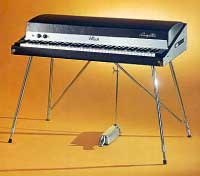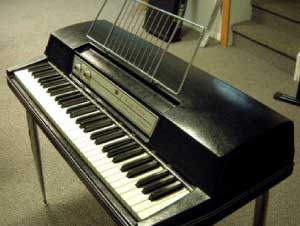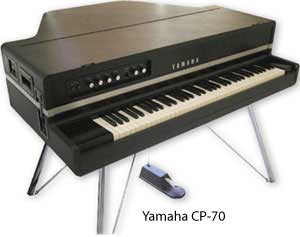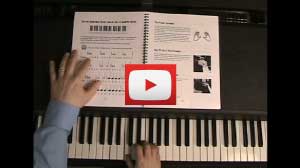Electric Pianos
The Fender Rhodes Piano

Fender Rhodes electric pianos were invented by Harold Rhodes, who was called "America's piano teacher" in the 1930's and 40's. He wanted to make a kind of kit piano for injured returning G.I.'s to build and learn on. He built the first Rhodes pianos from surplus post-war airplane parts.
In 1959, Rhodes partnered with Leo Fender of Fender guitar fame to launch the Rhodes piano. For the next 6 years they marketed the Rhodes bass keyboard. The full Rhodes piano was not launched until after CBS Musical Instruments purchased Fender in 1966.
The Rhodes piano was offered in 73 key and 88 key versions. Both versions were also offered as the "suitcase piano" and "stage piano"(shown in photo). The suitcase model featured an integral amp and speaker cabinet, and the stage model had removable legs, but had to be plugged into another amplifier.
The Rhodes used an "asymetrical" tuning fork design. One half of the tuning fork was a steel resonating bar whose length coincided with the note's pitch. This bar was attached to the "pin" block, and help to prolong the note's sustain. The other half of the "tuning fork" was a replaceable steel tine which could be tuned by moving a small spring which tightly grabs the tine.
The Rhodes action was a simplified piano action which at first used wooden parts, but later used mostly plastic interchangeable parts. The hammer, which had a felt or neoprene tip, struck the tine. The sound was generated by an electromagnetic pick up, which pointed to the end of the tine. The timber of the note could be changed by adjusting the hieght of the pick-up. Each note had its own pick-up, which sent its signal to a pre-amp.
Some of the more famous songs with the Rhodes piano include Stevie Wonder's "You Are The Sunshine Of My Life," The Beatles' "Get Back," The Doors' "Riders On The Storm" and Herbie Hancock's "Chameleon."
In 2007, The Rhodes piano was reborn, by a new company making the piano much the way it was made in the 1970's, but with an updated look.
The Wurlitzer Electric Piano

The Wurlitzer Electric piano was first introduced in 1955. Wurlitzer was one of America's leading mid-line piano companies, known for its sturdy and good-looking spinet and console upright pianos. Though they did make some grands, most of their market was with vertical pianos.
In their electric pianos (which they initially called "electronic") they employed a mini grand-style action mechanism. The hammer struck a single steel reed, with an electrostatic pick-up making the signal to be amplified.
The reeds are known to go out of tune from metal fatigue, and eventually break. Tuning the reeds is no easy task. A drop of solder on the end of the reed has to be filed to create the correct pitch, and if too much is filed, more solder has to be added. The person tuning has to be careful with the solder filings, which can attach to the pick-up and other electrical parts.
The earliest Wurlitzer electrics were built into a fiberboard case and used tubes in the amplifier, which drove a single built-in speaker. In 1962, the amplifier was changed to a solid state design, and drove two speakers mounted in a sturdy plastic covering. The "Wurly" has removable legs, making it portable, though they did manufacture a few console versions.
Wurlitzer stopped making electrics in 1982 when they discontinued their last model, the 200A (shown in photo).
The Wurlitzer electric can be heard on many hit records including Ray Charles' "What I'd Say," Supertramp's "Bloody Well Right," Aretha Franklin's "Never Loved A Man," and Steely Dan's "Do It Again"
Other Electric Pianos

Most of the other electric pianos manufactured used hammers, strings and piezoelectric pick-up mechanisms. Most were bulky, not very portable, and difficult to keep in tune when they were moved often. Generally these type of electric pianos weighed 300 pounds or more.
Baldwin, Kawai, Helpinstill and Yamaha were the most notable makers of these types of pianos, which boasted a more realistic piano sound as compared to the Rhodes and Wurlitzer. Only the Yamaha CP-70 (shown in photo) gained widespread use, and was becoming almost as popular as the Fender Rhodes piano in the early 1980's, until the first digital pianos were introduced. The "digital revolution" with lighter keyboards featuring more sounds "killed" these electric pianos.
The Hohner Pianet was an electric piano not widely used, but it did make it on to some notable recordings in the 1960's. Its sound is similar to the Wurlitzer, but brighter with less sustain. This sound can be heard on The Zombie's "She's Not There," The Kingsmen's "Louie, Louie," The Beatles' "The Night Before" and "Tell Me What You See."
Start Playing Piano Today with the Piano Guide Quick Start Course!
Easy to follow step-by-step lessons designed for adult beginners. The next best thing to private lessons!
What You'll Learn:
- Notes on the piano/keyboard
- Proper fingering
- C major scale
- Chords
- How to read music
- And much more!

Video lessons - watch as I play everything for you.

